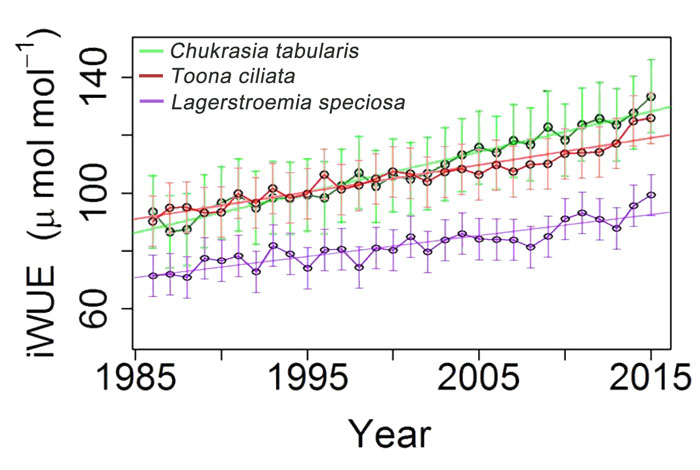Large Increases in the Water Use Efficiencies of Three Tropical Forest Trees
Rahman, M., Islam, M., Gebrekirstos, A. and Bräuning, A. 2020. Disentangling the effects of atmospheric CO2 and climate on intrinsic water-use efficiency in South Asian tropical moist forest trees. Tree Physiology 40: 904-916.
Numerous scientific studies have been conducted in both laboratory and field environments to examine the impact of rising atmospheric CO2 on plant water use efficiency (WUE). In nearly all instances those studies reveal rising CO2 improves plant WUE, typically by reducing plant stomatal apertures, which reduces water lost to the air via transpiration. Consequently, at higher levels of CO2, plants tend to need less water to produce the same (or more) amount of tissue, which portends great benefits for the future of agricultural production, especially in arid and irrigated regions.
In recent years, proof of this concept has emerged in studies examining historic trends in the stable carbon isotope ratio (δ13C) of tree rings, which have been utilized to infer long-term changes in intrinsic WUE (iWUE). The latest group of scientists to conduct such a study is that of Rahman et al. (2020). Working in Bangladesh, the four researchers examined tree-ring cores from three moist tropical forest species, Chukrasia tabularis, Toona ciliate and Lagerstroemia speciose, producing an iWUE record spanning the three-decade period 1986-2015. The results are presented below in Figure 1.
As illustrated there, iWUE increased by a very respectable 29% for T. ciliate, 29% for L. speciose, and 46% for C. tabularis over the 30-year period. With regard to the cause of these increases, statistical analyses revealed the long-term 53 ppm rise in atmospheric CO2 explained nearly all of it (86%), followed by slight influences from temperature and precipitation. Consequently, Rahman et al. conclude the “long-term iWUE trends are driven mainly by the increasing atmospheric CO2 and not by temperatures or precipitation,” which conclusion they add is right in line with similar iWUE studies conducted in tropical, boreal, Mediterranean and subtropical forests, citing a number of studies in this regard.
And thus we find yet another real world example that rising atmospheric CO2 is benefitting vegetation across the globe by helping to improve plant iWUE. Amazingly, a mere 15% increase in CO2 was powerful enough to raise the intrinsic water use efficiencies of these tropical forest tree species by 29-46%. And if CO2 can do that in just three decades, imagine what it can do over a lifetime!

Figure 1. Annual variability and long-term trends in intrinsic water-use efficiency (iWUE) of three South Asian tropical moist forest tree species over the period 1986-2015. Adapted from Rahman et al. (2020).
This article appeared on the CO2 Science website at http://www.co2science.org/articles/V24/feb/a12.php
]]>